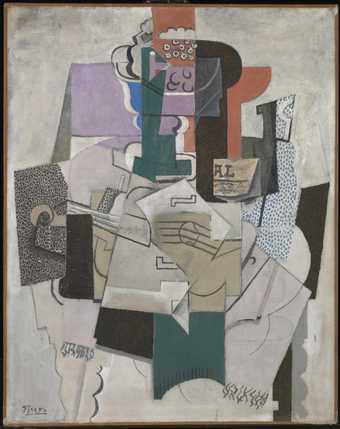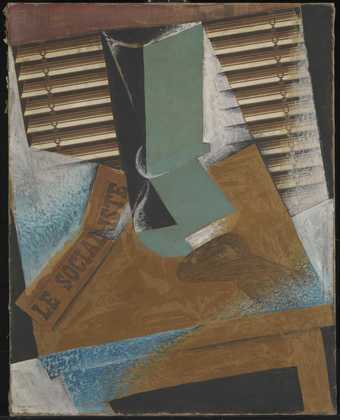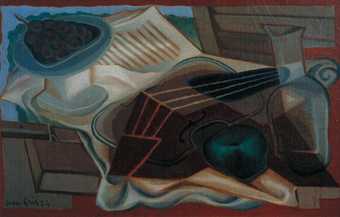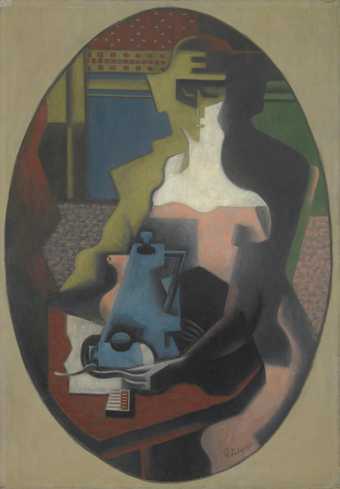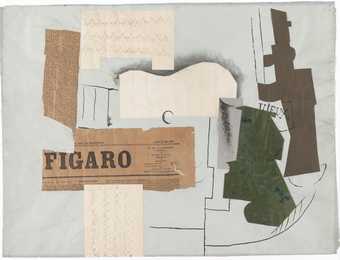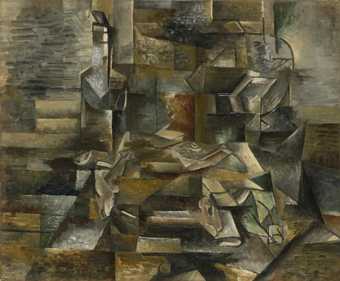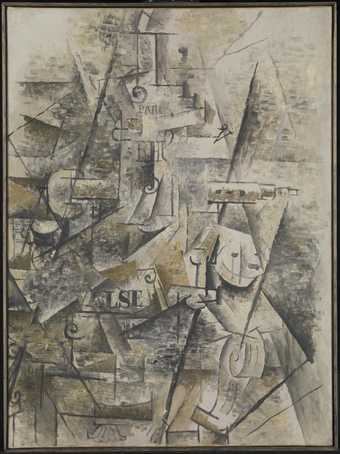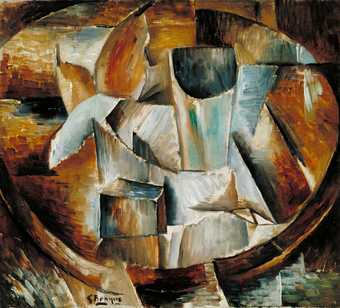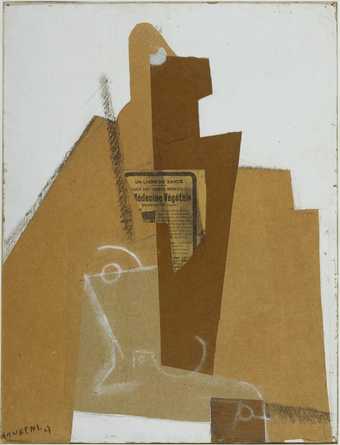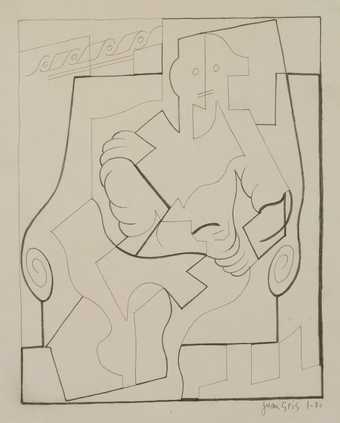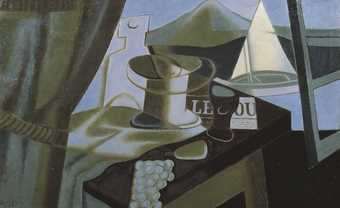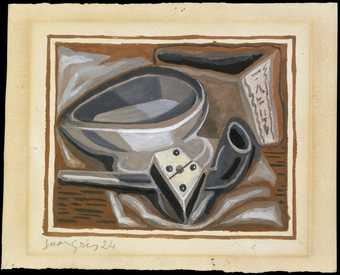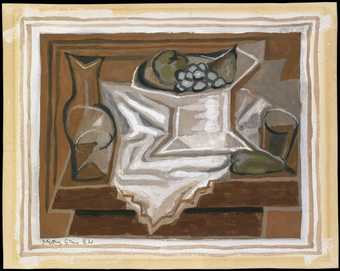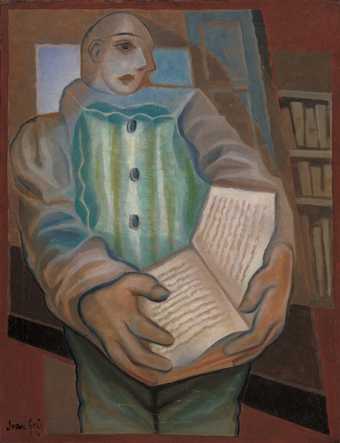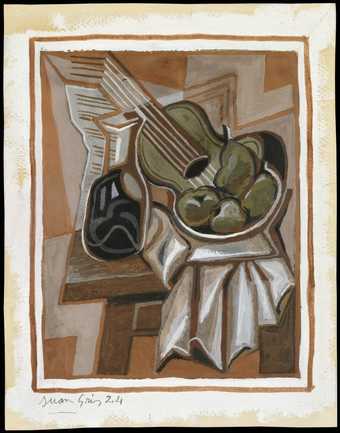
In Tate Modern
- Artist
- Juan Gris 1887–1927
- Original title
- La Bouteille de rhum et le journal
- Medium
- Oil paint on canvas
- Dimensions
- Support: 460 × 370 mm
frame: 647 × 555 × 67 mm - Collection
- Tate
- Acquisition
- Presented by Gustav and Elly Kahnweiler 1974, accessioned 1994
- Reference
- T06808
Summary
Juan Gris first began to paint in a cubist manner in 1912 and, under the influence of his close friends Picasso and Braque, he quickly progressed through analytical cubism, with its faceted forms and shifting perspectives, to synthetic cubism, using overlapping flat planes of colour and texture.
In this most radical form of the cubist idiom, nature was no longer a necessary starting point. Instead, coloured planes could provide the architecture for imagery that the artist could develop towards something representative. Daniel-Henry Kahnweiler, who was Gris’s close friend and dealer, wrote of the artist’s method: ‘He started with the ensemble, whose rhythm he allowed to develop freely. From this rhythm sprang, in their turn, the objects. A few simple “stimulants” sufficed to make the spectator “see” the desired object. Parallel lines drawn on a white surface changed it into a page of music; lines of type turned it into a newspaper; a flatly drawn ring made it into a plate.’ (Kahnweiler 1969, p.146.) Objects in such works were often no more than signs, which had to be read imaginatively by the spectator in order to be understood.
In Bottle of Rum and Newspaper Gris constructed the image from intersecting angular planes. Many of these have fake wood grain, suggestive perhaps of a wooden table top, though the way they overlap and interlock denies any possibility of recession or perspective. The bottle and the newspaper are indicated with a bare minimum of clues: a few letters, an outline and hint of local colour are sufficient to indicate the identity of the objects. The complexity of the work, however, lies in the suggestion that the overlapping and interpenetrating planes may represent to some degree visual memories of different views onto the objects. Such a painting, Kahnweiler was to insist, was conceptual in the sense that it was to be understood fully only through the use of the spectator’s imagination.
Further reading
Daniel-Henry Kahnweiler, Juan Gris: His Life and Work, translated by Douglas Cooper, London 1969
Jennifer Mundy, ‘Juan Gris’, in Jennifer Mundy (ed.), Cubism and its Legacy: The Gift of Gustav and Elly Kahnweiler, exhibition catalogue, Tate Modern, London 2004, pp.34-44, reproduced p.37 in colour
Jennifer Mundy
December 2003
Revised by Giorgia Bottinelli
June 2004
Does this text contain inaccurate information or language that you feel we should improve or change? We would like to hear from you.
Display caption
Like many cubist works, Gris’s painting provides a revised experience of the everyday, whether in the studio or in a familiar café. Glimpsed letters confirm the positions of the two objects: UM for rum, JOUR (of ‘journal’) for the newspaper. A table is indicated by the false wood-graining, a house-painter’s skill much admired by the cubists because it is identifiably an illusion. Gris interweaves these fragmentary images of the familiar into a complex, carefully balanced structure.
Gallery label, August 2013
Does this text contain inaccurate information or language that you feel we should improve or change? We would like to hear from you.
Explore
- abstraction(8,615)
-
- from recognisable sources(3,634)
-
- man-made(999)
- formal qualities(12,454)
-
- assemblage / collage(47)
- texture(466)
- food and drink(980)
-
- drink, rum(2)
- table(754)
- bottle(289)
You might like
-
Pablo Picasso Bowl of Fruit, Violin and Bottle
1914 -
Juan Gris The Sunblind
1914 -
Juan Gris Violin and Fruit-Dish
1924 -
Jean Metzinger Woman with a Coffee Pot
1919 -
Pablo Picasso Bottle of Vieux Marc, Glass, Guitar and Newspaper
1913 -
Georges Braque Bottle and Fishes
c.1910–12 -
Georges Braque Clarinet and Bottle of Rum on a Mantelpiece
1911 -
Georges Braque Glass on a Table
1909–10 -
Henri Laurens Bottle and Glass
1917 -
Juan Gris Seated Harlequin
1920 -
Juan Gris Overlooking the Bay
1921 -
Juan Gris Pipe and Domino
1924 -
Juan Gris Bowl of Fruit
1924 -
Juan Gris Pierrot with Book
1924 -
Juan Gris Still Life with Guitar
1924

